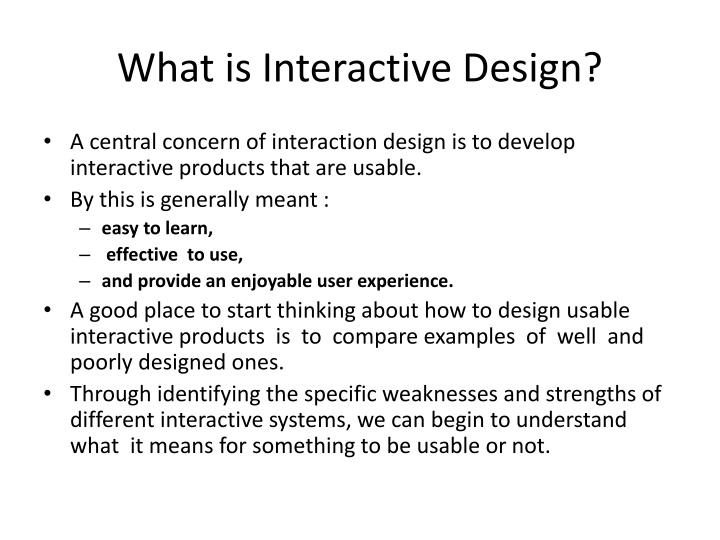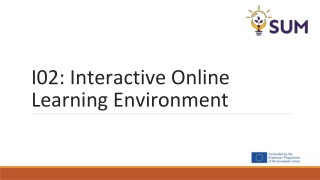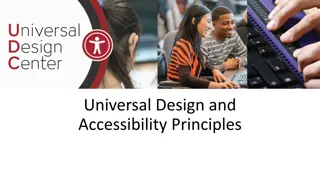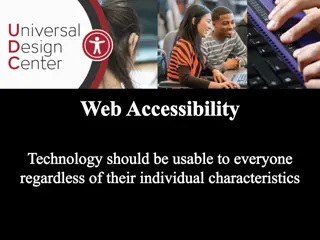Interactive Design: Developing Usable Products
Central concern of interaction design is to develop interactive products that are usable - easy to learn, effective to use, and provide an enjoyable user experience. Designing usable interactive products requires understanding user activities and choosing appropriate interfaces. It involves making informed choices to optimize user interactions based on user understanding.
Download Presentation

Please find below an Image/Link to download the presentation.
The content on the website is provided AS IS for your information and personal use only. It may not be sold, licensed, or shared on other websites without obtaining consent from the author.If you encounter any issues during the download, it is possible that the publisher has removed the file from their server.
You are allowed to download the files provided on this website for personal or commercial use, subject to the condition that they are used lawfully. All files are the property of their respective owners.
The content on the website is provided AS IS for your information and personal use only. It may not be sold, licensed, or shared on other websites without obtaining consent from the author.
E N D
Presentation Transcript
What is Interactive Design? A central concern of interaction design is to develop interactive products that are usable. By this is generally meant : easy to learn, effective to use, and provide an enjoyable user experience. A good place to start thinking about how to design usable interactive products is to compare examples of well and poorly designed ones. Through identifying the specific weaknesses and strengths of different interactive systems, we can begin to understand what it means for something to be usable or not.
What to Design? Designing usable interactive products thus requires considering who is going to be using them and where they are going to be used. Another key concern is understanding the kind of activities people are doing when interacting with the products. The appropriateness of different kinds of interfaces and arrangements of input and output devices depends on what kinds of activities need to be supported. For example, if the activity to be supported is to let people communicate with each other at a distance, then a system that allows easy input of messages (spoken or written) that can be readily accessed by the intended recipient is most appropriate. In addition, an interface that allows the users to interact with the messages (e.g., edit, annotate, store) would be very useful.
What to Design? (Contd.) The range of activities that can be supported is diverse. Just think for a minute what you can currently do using computer- based systems: send messages, gather information, write essays, control power plants, program, draw, plan, calculate, play games-to name but a few. Now think about the number of interfaces and interactive devices that are available. They, too, are equally diverse: multimedia applications, virtual-reality environments, speech-based systems, personal digital assistants and large displays-to name but a few. There are also many ways of designing the way users can interact with a system e.g., via the use of menus, commands, forms, icons, etc.
What to Design? (Contd.) What this all amounts to is a multitude of choices and decisions that confront designers when developing interactive products. A key question for interaction design is: how do you optimize the users' interactions with a system, environment or product, so that they match the users' activities that are being supported and extended? One could use intuition and hope for the best.
What to Design? (Contd.) Alternatively, one can be more principled in deciding which choices to make by basing them on an understanding of the users. This involves: taking into account what people are good and bad at considering what might help people with the way they currently do things thinking through what might provide quality user experiences listening to what people want getting them involved in the design using "tried and tested" user- based techniques during the design process.
The process of interaction design Essentially, the process of interaction design involves four basic activities: Identifying needs and establishing requirements. Developing alternative designs that meet those requirements. Building interactive versions of the designs so that they can be communicated and assessed. Evaluating what is being built throughout the process. These activities are intended to inform one another and to be repeated. For example, measuring the usability of what has been built in terms of whether it is easy to use provides feedback that certain changes must be made or that certain requirements have not yet been met.
The process of interaction design (Contd.) Evaluating what has been built is very much at the heart of interaction design. Its focus is on ensuring that the product is usable. It is usually addressed through a user-centered approach to design, which, as the name suggests, seeks to involve users throughout the design process. There are many different ways of achieving this: for example, through observing users, talking to them, interviewing them, testing them using performance tasks, modeling their performance, asking them to fill in questionnaires, and even asking them to become co-designers.
The process of interaction design (Contd.) A main reason for having a better understanding of users is that different users have different needs and interactive products need to be designed accordingly. In addition to the four basic activities of design, there are three key characteristics of the interaction design process: Users should be involved through the development of the project. Specific usability and user experience goals should be: identified, clearly documented, and agreed upon at the beginning of the project. Iteration through the four activities is inevitable.
The goals of interaction design Part of the process of understanding users' needs, with respect to designing an interactive system to support them, is to be clear about your primary objective. Is it to design a very efficient system that will allow users to be highly productive in their work, or is it to design a system that will be challenging and motivating so that it supports effective learning, or is it something else? We call these top-level concerns usability goals and user experience goals. Usability goals are concerned with meeting specific usability criteria (e.g., efficiency). User experience goals are largely concerned with explicating the quality of the user experience (e.g., to be aesthetically pleasing).
The goals of interaction design Usability Goals Usability is generally regarded as ensuring that interactive products are easy to learn, effective to use, and enjoyable from the user's perspective. It involves optimizing the interactions people have with interactive products to enable them to carry out their activities at work, school, and in their everyday life. More specifically, usability is broken down into the following goals: effective to use (effectiveness): is a very general goal and refers to how good a system is at doing what it is supposed to do. efficient to use (efficiency): the way a system supports users in carrying out their tasks. safe to use (safety) : Safety involves protecting the user from dangerous conditions and undesirable situations. have good utility (usefulness) : the extent to which the system provides the right kind of functionality so that users can do what they need or want to do. easy to learn (learnability) : how easy a system is to learn to use. easy to remember how to use (memorability) : how easy a system is to remember how to use, once learned.
The goals of interaction design User Experience Goals satisfying enjoyable fun entertaining helpful motivating aesthetically pleasing supportive of creativity rewarding emotionally fulfilling























